Sheikh Heidar Mausoleum | A Must-See in Meshgin Shahr
Meshgin Shahr, a historic city in Ardabil province, is known for its rich history and numerous attractions, including the Sheikh Heidar Mausoleum and Yeri City.
Every year, this charming city draws a large number of tourists, particularly those exploring Ardabil. If you plan to visit Meshgin Shahr, the Sheikh Heidar Mausoleum should be a priority on your itinerary.
Interested in visiting Sheikh Heidar Mausoleum?
Check out our Iran tour packages to find an itinerary that includes visiting the Mausoleum
or...
Design your own tailor-made itinerary and include Sheikh Heidar Mausoleum in it by yourself, today!
The History of the Mausoleum: Who Was Sheikh Heidar?

Sheikh Haidar was a prominent figure in the history of the Safavid order and the father of Shah Ismail, the founder of the Safavid dynasty in Iran. Born shortly after his father’s death, he was raised under the care of Uzun Hasan. At a young age, following the death of Jahanshah Qaraqoyunlu at the hands of Uzun Hasan, Sheikh Haidar was brought to Ardabil under Hasan's protection. By the encouragement and support of those around him, Sheikh Haidar assumed the responsibilities of the Safavid shrine and monastery, earning respect as a distinguished mentor and influential Sufi.
Sheikh Haidar is remembered as a brave Sufi leader who fought valiantly against the Shirvanshahs, a conflict that ultimately led to his death. His followers transported his body to Meshgin Shahr, where a mausoleum was constructed in his honor, becoming a revered site for his disciples. The sanctity of this site led to its recognition as a place of pilgrimage, with some even referring to it as an Imamzadeh for many years.
History records that 22 years after Sheikh Haidar's death, his son, Shah Ismail, transferred his remains to Ardabil, where he was interred in the family tomb beside his great-grandfather, Sheikh Safiuddin.
| Related: Sheikh Safi al-Din Khanegah and Shrine Ensemble
Sheikh Heidar Mausoleum Architecture and Different Parts
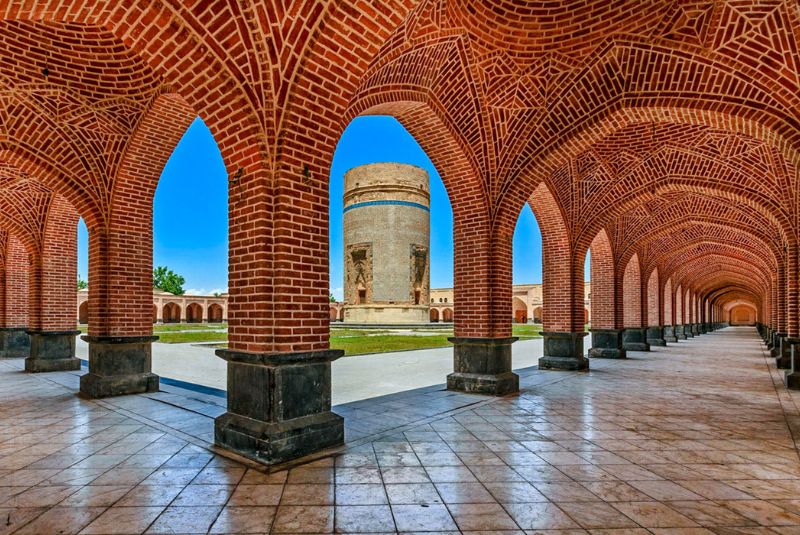
The Sheikh Heidar Mausoleum, often referred to as a castle, is a prime example of Ilkhanid architecture and stands as one of the most significant historical structures from this period in the Azerbaijan region. Currently undergoing restoration and landscaping, the mausoleum continues to capture the attention of historians and visitors alike.
The mausoleum's cylindrical structure rises to a height of 18.5 meters with a diameter of 10.9 meters. It is built upon a stone foundation that extends 0.5 meters below the stone road. Above this foundation, a wall made of lime mortar and plaster supports the structure.
| Read more: Elements of Persian Architecture
The mausoleum is divided into two floors: the upper level and a crypt below.
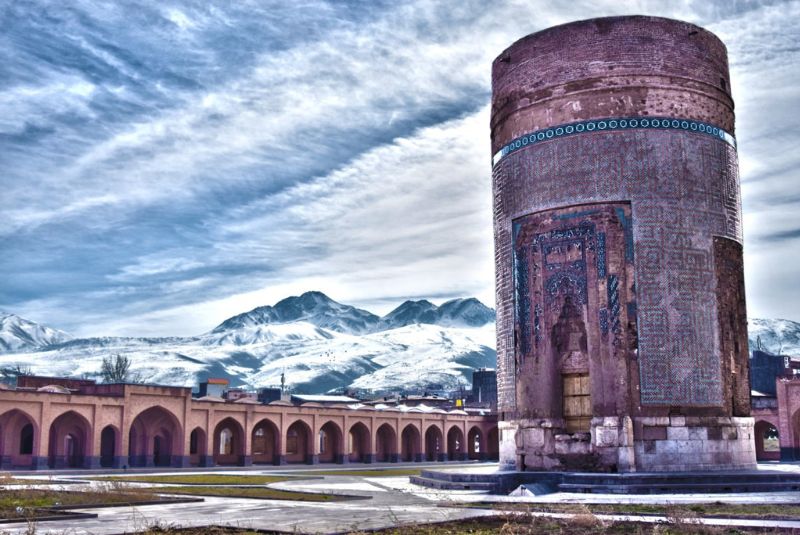
The crypt consists of two sections—an octagonal chamber with sides measuring approximately 2.2 meters and a rectangular section measuring 1.20 by 3.40 meters. The crypt is the final resting place of seven individuals. Among them, the grave attributed to Sheikh Heidar, father of Shah Ismail I of the Safavid dynasty, is located on the southern side of the mausoleum. The remaining unmarked graves are positioned on the eastern side of the main chamber. In 1973, a room was constructed to connect this area with the crypt.
Constructed primarily of brick, the mausoleum's exterior is adorned with turquoise-colored tiles featuring geometric patterns, the phrase "Glory of God," and verses from Surah Al-Fath. The main structure dates back to the 7th and 8th centuries AH, while the intricate tile work and decorations were added in the late 9th to early 10th centuries AH, during the Safavid period.
Two distinct types of tiling are used on the mausoleum's exterior. The first is mosaic work on the building's facades, while the second is a combination of brick and turquoise tile. Surrounding the tomb, lines of Rehani and Kufic script, though now mostly illegible due to erosion, can be seen in the brickwork. Traces of Kufic inscriptions and a beautiful moqarnas (stalactite) border remain on the sides and top of the building, though much of this detailing has unfortunately been lost over time.
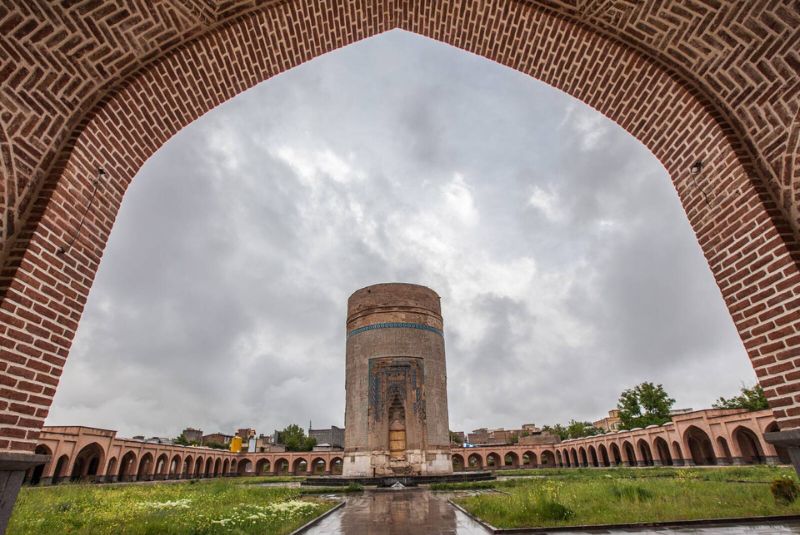
The four porches of the mausoleum showcase mosaic work adorned with white and blue tiles, bordered by moqarnas and featuring brick-colored lines and patterns, possibly depicting Quranic verses. The architecture and the date of the building’s construction were also inscribed in turquoise tiles, but much of this information has faded and is no longer readable.
Another form of combined tiling is seen in the turquoise-colored coatings that enhance the brick structure’s aesthetic appeal. Historical accounts suggest that the mausoleum once had a golden dome, which gleamed in the sunlight, with the words "Allah Allah" inscribed on its surface. However, during a battle between the Qojabiglou clan and Russian forces in 1275 AH, the dome was struck by a famous Russian gunner and was eventually looted.
| Discover: Sarein in Ardabil - Iran City of Hot Springs
Sheikh Heidar Mausoleum Inscription
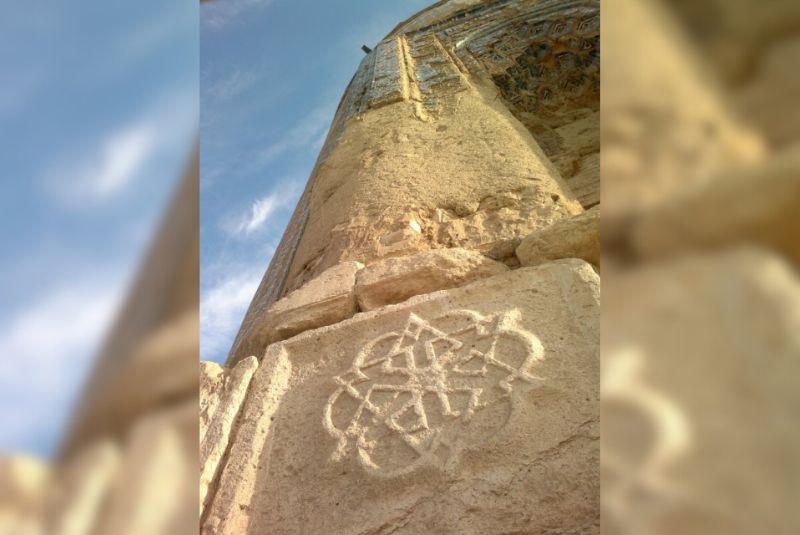
After centuries of obscurity, cultural heritage experts have finally managed to decipher the inscription on the Sheikh Heidar Mausoleum. Initially thought to be a combination of geometric designs and divine names, advanced analysis using computer software revealed that the inscription actually contains three verses from the Quran.
These verses are the concluding three of Surah Al-Fath, beginning with "Bismillah" and ending with "Sadaqallah," all inscribed in the distinctive Kufic script. This inscription is a testament to the architectural sophistication and cultural significance of the Ilkhanid era. Although the blue tiles that decorate the mausoleum's brick structure have experienced some deterioration, the remaining design elements, including the prominently inscribed word "Allah," still reflect the building’s enduring beauty. This particular inscription may have been inspired by the design found on the Dome of Sheikh Safiuddin Ardabili in Ardabil.
The mausoleum features a gabled dome roof that is circular on the exterior but reveals a twelve-sided structure on the inside. These twelve sides are believed to symbolize the Twelve Imams of Shia Islam, reflecting the deep devotion the Safavids held for these religious figures.
| Disocver: Bisotun - Rock Relief and Inscription of the Achaemenids
Location and Access
The Sheikh Heidar Mausoleum, honoring a descendant of Sheikh Safiuddin Ardabili, is situated in the city of Meshgin Shahr, 92 kilometers west of Ardabil's provincial capital. The mausoleum is located on North Bahonar Street, easily accessible by both private vehicles and public transportation. Visitors can enjoy a memorable experience at this historic site.
| Related: Shorabil Lake - Ardabil Must-See Attraction
Sheikh Heidar Mausoleum Visiting Information
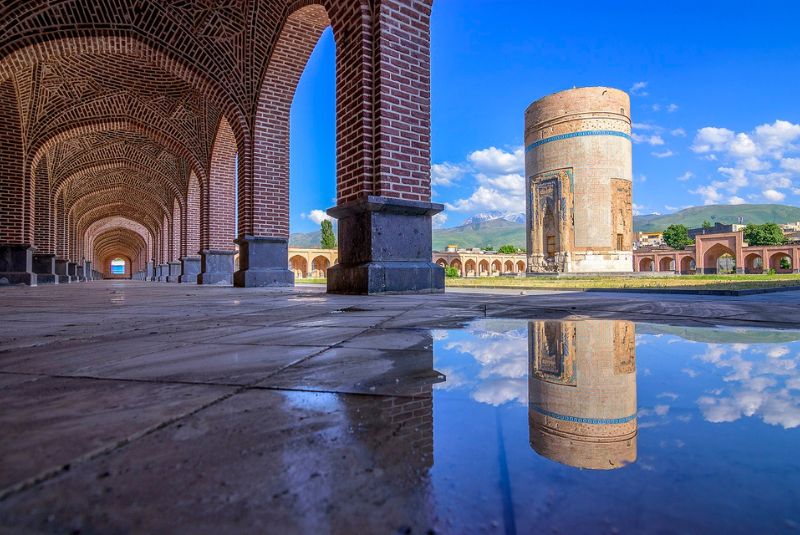
The Sheikh Heidar Mausoleum is part of a historical complex designed as a pedestrian-friendly area with a serene and beautiful environment. The site, particularly popular during the Nowruz holiday, attracts a large number of foreign tourists. This ancient monument is open to visitors daily, offering a glimpse into history and heritage. To enter, visitors are required to purchase a ticket.
Final Takeaway
The Sheikh Heidar Mausoleum is a significant monument and a valuable piece of history, making it a must-visit destination. When traveling through Iran and exploring Ardabil, be sure to add this remarkable site to your itinerary. Don't miss the chance to experience its rich cultural heritage firsthand.
Share your story!
Comment below and let us know about your Experience.
Your story inspires others!


Comment
Leave a Comment